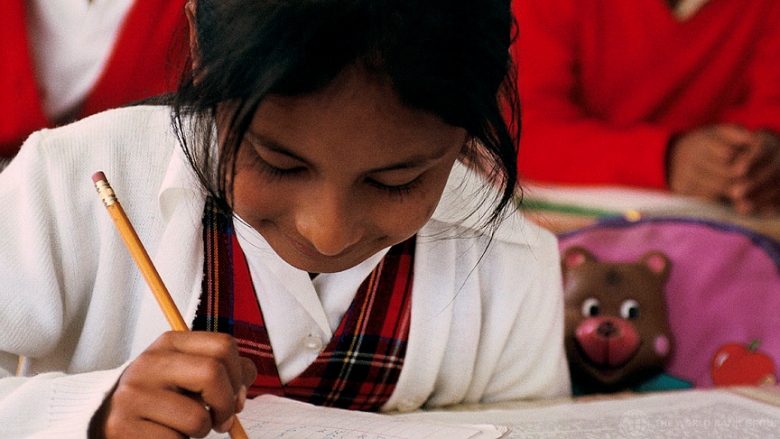Challenge
Mexican schools are seeking to improve the equity and quality of their education. Mexico’s performance in the Program for International Student Assessment (PISA) was the lowest among OECD countries in 2009 and learning outcomes as measured by the national standardized test National Evaluation of Academic Achievement in Schools (Evaluación Nacional del Logro Académico de Centros Escolares, ENLACE) in 2010 were also low, especially among the poor.
Solution
The World Bank-financed School-Based Management Project in Support of the Second Phase of the School-Based Management Program Project supported the expansion of the PEC School-Based Management (SBM) model by providing direct support to schools and technical assistance to develop school improvement plans, with the collaboration of the school director, teachers, parents, and students. Direct support averaged around US$4,000 per year, which provided schools with autonomy in managing extra resources to address their specific needs. The program’s targeted technical assistance to the states and the dissemination of a simplified school planning instrument (consisting of a manual with a series of recommendations intended to make the school planning process clearer, easier to understand, and more efficient for schools, while easily explaining the role of different stakeholders in collaborative SBM) was increased participation of schools serving indigenous and marginalized communities. It was also critical for encouraging greater participation of parents in the school life. In particular, parents were better able to contribute to the design and implementation of the school plan.
Results
The project focused on expanding the PEC SBM model with an emphasis on marginalized and indigenous schools. It supported improvements in several key outcomes, including: (1) increasing the percentage of PEC public and special education schools, and in particular of schools in marginalized and indigenous communities, and (2) the reorientation of the School Grants to improve public schools’ internal efficiency and learning outcomes. Main results included:
- The percentage of basic and special education schools participating in PEC increased from 20.30 percent in 2008-09 to 23.80 percent in 2013-14. This increase was equivalent to almost 10,000 additional schools participating in the program.
- The percentage of PEC schools in highly marginalized and marginalized areas increased from 38.40 percent in 2008-09 to 46 percent in 2012-13.
- The percentage of Indigenous modality schools participating in PEC increased from 15.40 percent in 2008-09 to 18 percent in 2012-13.
- Direct support to schools was reoriented to education quality inputs (from 59.7 percent in 2008-09 to 74.50 percent in 2012-13).
- The average ENLACE test score in PEC primary and secondary schools improved from 503 in Math in 2008-09 to 560 in 2012-13 for primary schools.
- The average pass rate in PEC primary and secondary schools improved from 96 percent in 2008-09 to 99 percent in 2012-13 for primary schools.
Bank Group Contribution
Overall, the Bank project supported approximately 75 percent of the total direct support to schools within the PEC. Schools received additional funds from states with a federal-to-state contribution of 3 to 1. Direct support to schools entailed 99.3 percent of loan funds. The rest of the project funds supported technical assistance to increase the number of participating schools (particularly those situated in marginalized and indigenous communities) and guide the implementation of the PEC program.
Partners
Project partners included the Ministry of Education (Secretaría de Educación Pública, SEP), the Full Time Schools Program (Programa Escuelas de Tiempo Completo, PETC), and the Support for School Management (Apoyos a la Gestión Escolar, AGE) program. These programs share the goal of contributing to students’ learning within a framework of increased school autonomy and social participation.
Moving Forward
The Bank is supporting the government with a new School Based Management Project, which provides support to PEC and PETC. The development objectives of this operation are to improve the schools’ managerial capacity and parental participation and to reduce dropout, repetition and failure rates among schools participating in PEC and PETC. The PEC is a top priority for the SEP, as it is seen as the program for spearheading the implementation of an ambitious reform launched in 2013 to improve the quality of education through, among others, strengthening SBM. The SBM policy is currently implemented through different national programs such the PEC, PETC, and the AGE. In addition, based on the lessons learned from this program, the use of evaluations to improve pedagogical strategies and managerial capacities at the school level is being introduced.
Beneficiaries
The project benefited public basic education (pre-primary, primary and lower secondary) schools participating in the PEC Program in all 31 states and the Federal District, while putting greater emphasis on marginalized areas and on the indigenous population. School directors, parents, teachers, and students in approximately 49,000 PEC schools and 7,669,759 students (annual average) benefited through the provision of direct support to schools and technical assistance to implement school improvement plans. Indirect beneficiaries were education authorities at the state level that received technical assistance to oversee the program and improve their prioritization of indigenous schools and schools in marginalized areas.

